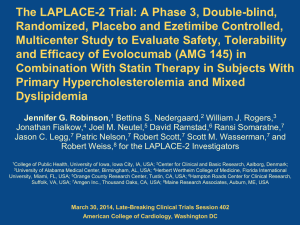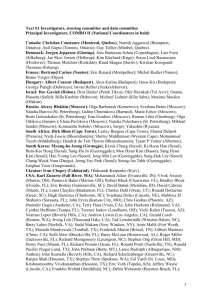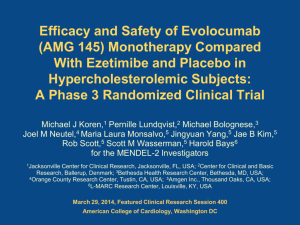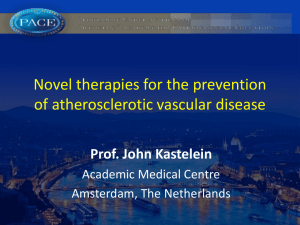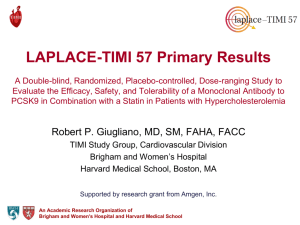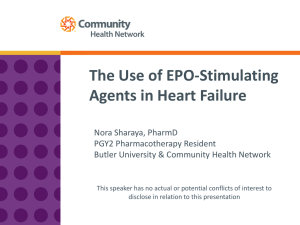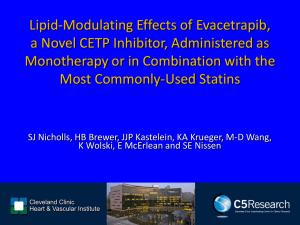RUTHERFORD-2 Presentation Slides
advertisement
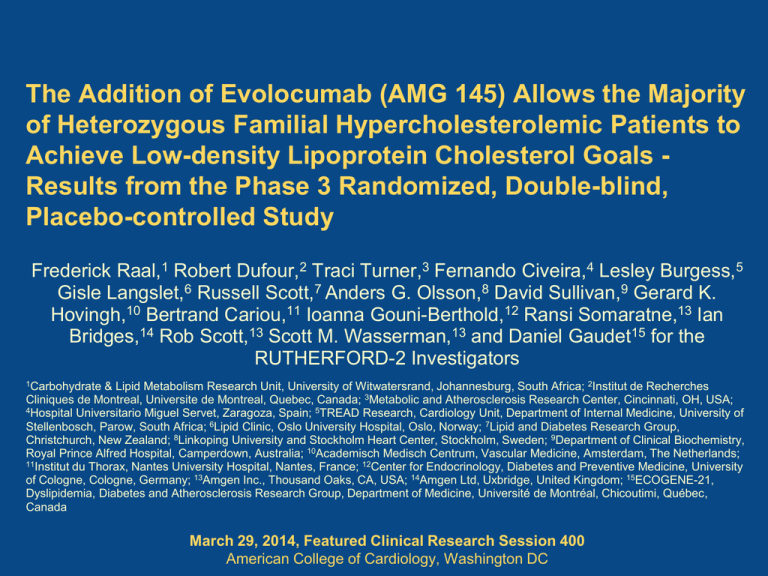
The Addition of Evolocumab (AMG 145) Allows the Majority of Heterozygous Familial Hypercholesterolemic Patients to Achieve Low-density Lipoprotein Cholesterol Goals Results from the Phase 3 Randomized, Double-blind, Placebo-controlled Study Frederick Raal,1 Robert Dufour,2 Traci Turner,3 Fernando Civeira,4 Lesley Burgess,5 Gisle Langslet,6 Russell Scott,7 Anders G. Olsson,8 David Sullivan,9 Gerard K. Hovingh,10 Bertrand Cariou,11 Ioanna Gouni-Berthold,12 Ransi Somaratne,13 Ian Bridges,14 Rob Scott,13 Scott M. Wasserman,13 and Daniel Gaudet15 for the RUTHERFORD-2 Investigators 1Carbohydrate & Lipid Metabolism Research Unit, University of Witwatersrand, Johannesburg, South Africa; 2Institut de Recherches Cliniques de Montreal, Universite de Montreal, Quebec, Canada; 3Metabolic and Atherosclerosis Research Center, Cincinnati, OH, USA; 4Hospital Universitario Miguel Servet, Zaragoza, Spain; 5TREAD Research, Cardiology Unit, Department of Internal Medicine, University of Stellenbosch, Parow, South Africa; 6Lipid Clinic, Oslo University Hospital, Oslo, Norway; 7Lipid and Diabetes Research Group, Christchurch, New Zealand; 8Linkoping University and Stockholm Heart Center, Stockholm, Sweden; 9Department of Clinical Biochemistry, Royal Prince Alfred Hospital, Camperdown, Australia; 10Academisch Medisch Centrum, Vascular Medicine, Amsterdam, The Netherlands; 11Institut du Thorax, Nantes University Hospital, Nantes, France; 12Center for Endocrinology, Diabetes and Preventive Medicine, University of Cologne, Cologne, Germany; 13Amgen Inc., Thousand Oaks, CA, USA; 14Amgen Ltd, Uxbridge, United Kingdom; 15ECOGENE-21, Dyslipidemia, Diabetes and Atherosclerosis Research Group, Department of Medicine, Université de Montréal, Chicoutimi, Québec, Canada March 29, 2014, Featured Clinical Research Session 400 American College of Cardiology, Washington DC Background: Heterozygous Familial Hypercholesterolemia (HeFH) HeFH is characterized by markedly elevated low-density lipoprotein cholesterol (LDL-C), and if untreated, is associated with significant premature cardiovascular morbidity and mortality.1 HeFH is most commonly caused by loss-of-function mutations in the LDLR gene.2 Although current treatments (e.g., statins +/- ezetimibe, bile acid sequestrants and/or niacin) can produce reductions in LDL-C of 50% – 65%, many HeFH patients are still unable to achieve recommended LDL-C targets.3 1. Eur Heart J 2013;34:3478-90 2. Ann Human Genet. 2008;72:485-98. 3. J Clin Lipidol. 2007;1:280-6. 2 The RUTHERFORD-2 Study Reduction of LDL-C with PCSK9 Inhibition in Heterozygous Familial Hypercholesterolemia Disorder (NCT20110117) Design: A 12-week, randomized, double-blind, placebo-controlled, multicenter phase 3 study Objective: To evaluate the efficacy and safety of evolocumab (AMG 145) 140 mg Q2W and 420 mg QM administered subcutaneously in a large cohort of HeFH patients unable to achieve an LDL-C < 100 mg/dL despite statin therapy with or without ezetimibe 3 RUTHERFORD-2 Study Design Evolocumab 420 mg SC QM N = 110 End of Study Screening Period with Placebo Injection Randomization Evolocumab 140 mg SC Q2W N = 111a 2:2:1:1 Placebo SC Q2W N = 55a Placebo SC QM N = 55 Max. 6 weeks Day 1 Week 2 Week 4b Week 6b Week Week 10 Week 12 Week 14c Evolocumab or placebo SC Q2W Evolocumab or placebo SC QM a b c N’s are number of patients randomized. One patient in each of the placebo Q2W and evolocumab Q2W groups did not receive any doses of the study drug and were not included in the analyses Injections at weeks 4 and 6 were done at home Week 14 was a follow-up call for Q2W patients to capture adverse events and concomitant medications Q2W, biweekly; QM, monthly; SC, subcutaneous 4 RUTHERFORD-2: Baseline Characteristics Placebo Q2W (N = 54) Evolocumab 140 mg Q2W (N = 110) Placebo QM (N = 55) Evolocumab 420 mg QM (N = 110) 51 (14) 53 (12) 47 (12) 52 (12) Female, % 46 40 44 42 Race: white, % 93 90 89 89 431 (124) 458 (145) 441 (146) 436 (139) Definite 83 77 78 76 Probable 17 23 22 24 Statin use, % 100 100 100 100 Ezetimibe use, % 61 61 66 62 Characteristic Age (years), mean (SD) PCSK9 (ng/mL), mean (SD) HeFH classificationa, % a Based on Simon Broome criteria HeFH, heterozygous familial hypercholesterolemia; Q2W, biweekly; QM, monthly; SD, standard deviation 5 RUTHERFORD-2: Baseline Lipids Characteristic Placebo Q2W (N = 54) Evolocumab 140 mg Q2W (N = 110) Placebo QM (N = 55) Evolocumab 420 mg QM (N = 110) LDL-Ca (mg/dL), mean (SD) 151 (37) 161 (51) 152 (43) 154 (43) ApoB (mg/dL), mean (SD) 114 (30) 119 (31) 110 (22) 115 (26) HDL-C (mg/dL), mean (SD) 53 (17) 50 (16) 49 (13) 52 (16) ApoA1 (mg/dL), mean (SD) 145 (28) 142 (34) 135 (24) 143 (29) Triglycerides (mg/dL), median (Q1, Q3) 96 (75, 143) 119 (87, 161) 102 (79, 151) 113 (85, 157) Lp(a) (nmol/L), median (Q1, Q3) 44 (24, 105) 78 (29, 206) 87 (36, 219) 61 (17, 194) a Determined by the Friedewald formula with reflexive testing via preparative ultracentrifugation when calculated LDL-C was < 40 mg/dL or triglyceride levels were > 400 mg/dL Apo, apolipoprotein; HDL-C, high-density lipoprotein cholesterol; LDL-C, low-density lipoprotein cholesterol; Lp(a), lipoprotein (a); Q2W, biweekly; QM, monthly; SD, standard deviation 6 RUTHERFORD-2: Mean % Change in LDL-Ca from Baseline to the Mean of Weeks 10 and 12, and Week 12 Alone Adjusted Mean Percent Change ± SE from Baseline Weeks 10 and 12 10 Week 12 20 2% 0 -10 6% 10 0 -1% -10 -20 -2% -20 -30 -30 -40 -40 -50 -50 -60 -60 -61% -70 -60%b -63% -66%b -61% -70 -59%b -56% -61%b Placebo Q2W (N = 54) Placebo QM (N = 55) Evolocumab 140 mg Q2W (N = 110) Evolocumab 420 mg QM (N = 110) a Determined by the Friedewald formula with reflexive testing via preparative ultracentrifugation when calculated LDL-C was < 40 mg/dL or triglyceride levels were > 400 mg/dL b P < 0.001; placebo-adjusted treatment difference analyzed using repeated measures model which included treatment group, stratification factors (from IVRS), scheduled visit and the interaction of treatment with scheduled visit as covariates 7 LDL-C, low-density lipoprotein cholesterol; Q2W, biweekly; QM, monthly; SE, standard error RUTHERFORD-2: LDL-Ca Goal Achievement < 70 mg/dL Weeks 10 and 12 Week 12 79%b 66%b 61%b 65%b 90 80 80% Proportion of Patients (%) 80 68% 70 63% 67% 70 60 60 50 50 40 40 30 30 20 20 10 10 2% 0 2% 2% 2% 0 Placebo Q2W (N = 54) Placebo QM (N = 55) Evolocumab 140 mg Q2W (N = 110) Evolocumab 420 mg QM (N = 110) a Determined by the Friedewald formula with reflexive testing via preparative ultracentrifugation when calculated LDL-C was < 40 mg/dL or triglyceride levels were > 400 mg/dL b P < 0.001; analyzed using CMH test, stratified by the stratification factors 8 LDL-C, low-density lipoprotein cholesterol; Q2W, biweekly; QM, monthly RUTHERFORD-2: Placebo-adjusted Treatment Differences in Other Lipids from Baseline to Week 12 Treatment Difference % Mean ± SE Treatment Difference % Mean ± SE -14 -24 -34 -44 -54 HDL-C Triglycerides -4 -49% -49% 9% 9% 14 12 10 8 6 4 2 0 Treatment Difference % Mean ± SE ApoA1 0 -5 -10 -15 -25 Lp(a) 9% -5 -10 -15 -20 -25 -30 -35 6 4 2 0 -32% -28% Evolocumab 140 mg Q2W vs. placebo Evolocumab 420 mg QM vs. placebo 10 8 -20% 0 -40 12 -12% -20 -30 Treatment Difference % Mean ± SE Treatment Difference % Mean ± SE ApoB 4% All evolocumab vs. placebo treatment differences were statistically significant at the P < 0.001 level (except for ApoA1, which was not part of the testing hierarchy); adjusted for multiplicity No notable difference were observed between the means of Weeks 10 and 12 and Week 12 alone Apo, apolipoprotein; HDL-C, high-density lipoprotein cholesterol; Lp(a), 9 lipoprotein (a); SE, standard error RUTHERFORD-2: Safety and Tolerability Adverse events (AEs), n (%) Treatment-emergent AEs Most common AEs in Evolocumab Patientsa Nasopharyngitis Headache Contusion Back pain Nausea Arthralgia Serious AEs AEs leading to discontinuation of study drug Deaths Potential injection-site reactionsb Neurocognitive AEsc Muscle-related SMQd Anti-evolocumab antibodies,e % Placebo (N = 109) Evolocumab (N = 220) 53 (48.6) 124 (56.4) 5 (4.6) 4 (3.7) 1 (0.9) 1 (0.9) 1 (0.9) 2 (1.8) 5 (4.6) 0 (0.0) 0 (0.0) 4 (3.7) 0 (0.0) 1 (0.9) - 19 (8.6) 9 (4.1) 9 (4.1) 8 (3.6) 8 (3.6) 8 (3.6) 7 (3.2) 0 (0.0) 0 (0.0) 13 (5.9) 0 (0.0) 10 (4.5) 0.0 Occurring in ≥ 3.5% of evolocumab-treated patients Reported using high-level term grouping, which includes injection site (IS) rash, IS inflammation, IS pruritus, IS reaction, and IS urticaria c Searched HLGT terms: Deliria (incl confusion); cognitive and attention disorders and disturbances; dementia and amnestic conditions; disturbances in thinking and perception; mental impairment disorders. d Standard Medical Dictionary for Regulatory Activities (MedDRA) Queries. e Binding or neutralizing 10 a b RUTHERFORD-2: Key Laboratory Results Laboratory Results ALT or AST > 3 × ULN at any post-baseline visit, % CK > 5 × ULN at any post-baseline visit, % CK > 10 × ULN at any post-baseline visit, % Placebo (N = 109) Evolocumab (N = 220) 0.0 0.0 1.8 0.0 0.9 0.0 ALT, alanine aminotransferase; AST, aspartate aminotransferase; CK, creatine kinase; ULN, upper limit of normal 11 RUTHERFORD-2: Conclusions Evolocumab administered either biweekly or monthly yielded significant reductions in LDL-C in HeFH patients on statins with or without ezetimibe. The mean reduction of LDL-C at Week 12 was 61% in the 140 mg Q2W and 56% in the 420 mg QM evolocumab dose groups, respectively. The mean reduction of LDL-C at the mean of Weeks 10 and 12 was 61% in the 140 mg Q2W and 63% in the 420 mg QM evolocumab dose groups, respectively. Evolocumab 140 mg biweekly and 420 mg monthly dosing regimens were clinically equivalent. The majority of patients achieved LDL-C targets. Evolocumab treatment resulted in favorable changes in other 12 lipoproteins. RUTHERFORD-2: Conclusions Evolocumab was well tolerated, with no notable difference in the AE profile compared with placebo. The rate of nasopharyngitis and muscle-related adverse events (AEs) was higher in the evolocumab group. • The imbalance in the overall set of muscle-related AEs was not due to significant imbalances in any individual muscle-related event (i.e., creatine kinase). Evolocumab may offer a new and effective treatment option to further reduce LDL-C in HeFH patients. 13
